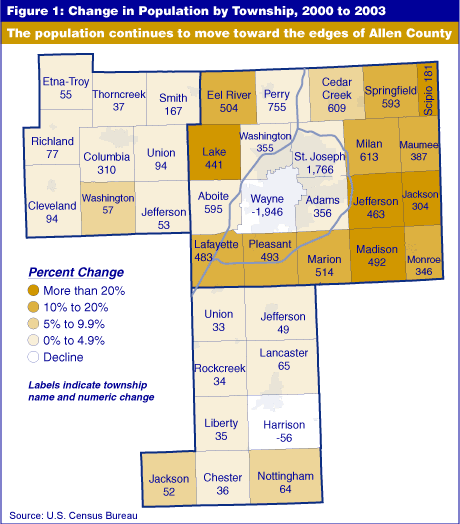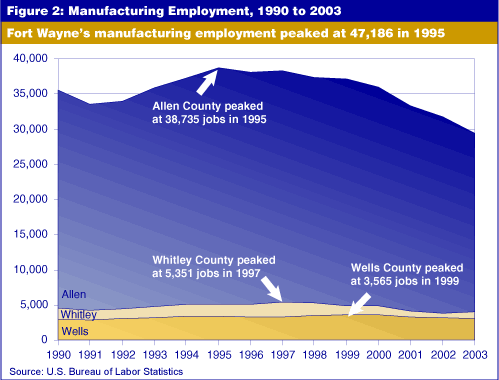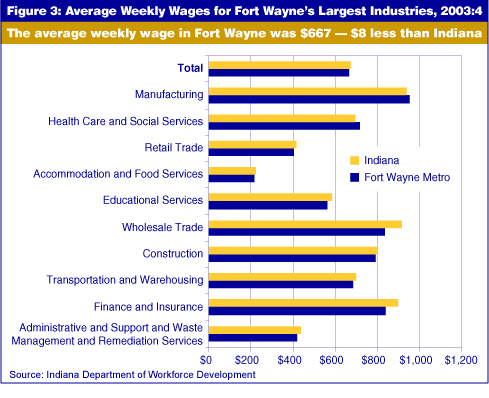The Fort Wayne Metro Area
The Area
The Fort Wayne Metropolitan Statistical Area (metro) consists of Allen, Wells and Whitley counties in northeast Indiana. Cities in the region include Fort Wayne, New Haven, Bluffton and Columbia City.

Those familiar with the federal definitions of metros might notice that the Fort Wayne metro actually lost counties in the 2003 redefinition, contrary to the expansion that occurred in most other metro definitions across the country. Adams, De Kalb and Huntington counties, all formerly part of the Fort Wayne metro, are not growing any less metropolitan, per se; rather, each became its own micropolitan statistical area (micro) covering Decatur, Auburn and Huntington, respectively. Those three, plus the Kendallville micro (Noble County), join the Fort Wayne metro to form the Fort Wayne-Huntington-Auburn Combined Statistical Area, of use to those desiring statistics on the broader region.
The city of Fort Wayne is the second largest in the state with a 2003 population of 219,495. That’s about 1,000 residents less than reported in Census 2000, showing a drop of 0.4 percent. Returning to the three-county metro definition of Allen, Wells and Whitley, the region had nearly 400,000 people, with the vast majority (340,153) living in Allen County.
At 2.5 percent, the metro’s growth exceeded the state’s between 2000 and 2003. Whitley led the charge with a 3.1 percent growth, surpassing Indiana by 1.2 percentage points. Of course, this gain was less than 950 people. Meanwhile, Allen County added 8,304 residents, a growth of 2.5 percent. Combining the population loss in the city itself with the gains made by the county during the same time period, this indicates a rather pronounced suburbanization in the outskirts of Allen County. Population change by township perhaps illustrates the pattern best (see Figure 1).

Projections from the Indiana Business Research Center indicate that the Fort Wayne metro will grow 10.4 percent from Census 2000 levels by 2020, adding just over 40,700 residents. Wells County is expected to lose a bit of its metro share, with growth around 28 percent, compared to a 52 percent growth in Whitley County and a 42 percent growth in Allen County.
Industrial Mix and Jobs
Manufacturing accounted for 17.7 percent of Fort Wayne’s employment in the fourth quarter of 2003. While the largest piece of the employment pie, manufacturing is a slightly smaller piece than in the state overall (20 percent).
With the redefinition of the industry sectors and conversion to NAICS in 2001, long-term industry changes were not available for analysis. The Bureau of Labor Statistics has now converted some of the older SIC data to NAICS, giving us a limited ability to look at the recent history of some industries. Figure 2 shows that, from 1990 to 2003, manufacturing jobs declined 17.2 percent in Allen County and 10.3 percent in Whitley County. Meanwhile, Wells County gained 4.2 percent. This yields a decline for the entire metro of 15 percent, compared to a 6 percent drop for the state during that same time period. Falling from a 1995 peak of 47,186 jobs, manufacturing accounted for 36,566 jobs in the Fort Wayne metro in 2003.

General Motors Truck Group and BFGoodrich Tire both remain major manufacturers in the region. GM recently announced it is considering investing $175 million into its Fort Wayne plant, which makes Chevrolet Silverado and GMC Sierra full-size pickups, although that expansion is just in the planning stages.
Franklin Electric in Wells County (manufacturing submersible water and fueling systems motors) is one of just two Indiana companies to make Forbes’ list of the 200 best small companies in 2004, with a rank of 150. (The other Indiana company, Cohesant Technologies in Indianapolis, ranked 149th.) Another small company, Autoliv in Whitley County (producing seat belts, airbags and other automotive safety products), recently announced plans to invest $24.5 million to double its facility size and triple its workforce (currently about 320 employees) over the next five years.
Health care and social services was the next highest employer in the Fort Wayne metro (14.2 percent by fourth quarter 2003). The Community Research Institute at Indiana University – Purdue University Fort Wayne indicates that Parkview Health Systems and the Lutheran Health Network are two of Allen County’s largest employers.
21st Century Logistics
Fort Wayne is targeting the transportation, distribution and logistics (TDL) sector for further development. This year, the legislature passed temporary tax abatements on new logistics and information technology equipment for businesses in six counties along I-69, providing a useful incentive to the metro in attracting and supporting businesses.
TDL seems a good fit for the Fort Wayne area because of the existing infrastructure, the number of manufacturers in the region who need to transport their goods, as well as the number of renowned TDL companies already in the metro. Triple Crown has ranked first among intermodal service providers by the Logistics Management and Distribution Report for three straight years, and Kitty Hawk, providing wholesale airport freight transportation, has a state-of-the-art sorting hub at the Fort Wayne International Airport.
The benefits of TDL are that many of its jobs are not susceptible to outsourcing (tied as they are to physical location and transportation), wages are relatively high, and the sector is expanding nationwide. Locally, SIRVA, a global relocation and moving services company, continues to invest and add jobs at its Allen County operation. Federal Express built a new 56,000 square-foot ground operations center in New Haven in 2003. Triple Crown and TransWorks (providing computer-based transportation tools) are both expanding. Those two operations are subsidiaries of Norfolk Southern Railroad, which has invested $2.7 million to build an additional half-mile of track in New Haven to eliminate a bottleneck where two tracks converged.
Major infrastructure enhancements possibly in Fort Wayne’s future include the I-69 expansion in southern Indiana, which furthers the goal of a “NAFTA Superhighway,” and the building of a mostly new U.S. 24 to connect Fort Wayne to the port in Toledo, Ohio.
Find additional information on the transportation, distribution and logistics sector throughout the state of Indiana at www.indianalogistics.com.
Wages and Income
The average weekly wage in Fort Wayne was $667 — $8 less than the state — for the fourth quarter of 2003. By sector, these wages ranged from $216 in accommodation and food services to $1,102 in management of companies and enterprises. While those managers make the most in the metro, those wages are more than $200 less per week than in the state overall. Only four industries in the Fort Wayne metro had average wages exceeding the state: information, real estate and rental and leasing, health care and social services, and manufacturing. Figure 3 shows the wage differences for the metro’s largest industries.

Per capita personal income (PCPI) in the metro area was $28,965 in 2002, more than 3 percent higher than the state per capita. PCPI in Allen County ($29,493) exceeded Wells County by nearly $4,200 and Whitley County by almost $3,000.
Rachel Justis
IN Context Managing Editor, Indiana Business Research Center, Kelley School of Business, Indiana University

